Library of Congress's Blog, page 180
December 18, 2012
InRetrospect: November Blogging Edition
In November, Library bloggers presented a feast of posts, sure to whet a variety of appetites. Here are a few selections.
In the Muse: Performing Arts Blog
1707: A Year That Will Resonate with Handel Lovers
1707 was a good year for Handel.
The Signal: Digital Preservation
When Data Loss is Personal
Leslie Johnston talks about being robbed and lessons learned for protecting personal data.
Picture This: Library of Congress Prints & Photos
Happy Thanksgiving
Mr. and Mrs. Crouch in Ledyard, Conn., enjoy the holiday and pie with their family.
From the Catbird Seat: Poetry & Literature at the Library of Congress
Poetry at Work
Caitlin Rizzo welcomes new poetry traditions.
Inside Adams: Science, Technology & Business
Pic of the Week: Sequoyah
Native American Heritage Month is celebrated.
In Custodia Legis: Law Librarians of Congress
The Electoral College – What is it and How Does it Function?
Legal reference librarians Barbara Bavis and Robert Brammer explain the Electoral College.
Teaching with the Library of Congress
Thanksgiving and Football: A Unique American Tradition
Watching football is part of Thanksgiving celebrations for many Americans.
December 13, 2012
Fa la la la la
This Saturday marks my return to the Kennedy Center stage singing as part of The Washington Chorus in our annual series of holiday concerts. I’ve been a part of this large ensemble for about three years now, and our December concerts are some of our most popular. There’s nothing like singing yuletide carols to get people in a festive spirit, and our audience is always encouraged to sing along.
During the holidays, we all have tried-and-true tunes we enjoy. A search for “Christmas” in the National Jukebox uncovers recordings of holiday classics and some not-so-classic.
Some favorites on tap for the chorus program include “The Twelve Days of Christmas,” “Hark! The Herald Angels Sing,” “O Come All Ye Faithful,” “Joy to the World,” “Silent Night,” “Good King Wenceslas” and “The Hallelujah Chorus.”
Developed by the Library of Congress, with assets provided by Sony Music Entertainment, the National Jukebox offers free online access to a vast selection of music and spoken-word recordings produced in the U.S. between the years 1901 and 1925. More than 10,000 historic sound recordings are available to the public for the first time digitally.
Visitors to the National Jukebox are able to listen to available recordings on a streaming-only basis, as well as view thousands of label images, record-catalog illustrations and artist and performer bios. In addition, users can further explore the catalog by accessing special interactive features, listening to playlists curated by Library staff, and creating and sharing their own playlists.
Also as part of The Washington Chorus program, we’re singing two versions of a carol previously unfamiliar to me, “In Dulci Jubilo” – one by Praetorius and the other by Scheidt. This year, why not incorporate some new songs to your yuletide collection – how about “Sylvia’s Christmas Song” or “It’s Not a Regular Christmas, Unless You’re with the Folks Back Home.”
Thanks to the Library’s Historic Sheet Music Collection, you can gather around the piano and try your hand at approximately 9,000 items published from 1800 to 1922.
What are some of your favorite holiday carols?
December 11, 2012
Curator’s Picks: Exposing Cartoon Art
The collections of the Library of Congress are vast and varied. And, what better way to get to know them but through our many wonderful curators. In this edition of “Curator’s Picks,” Sara Duke, curator of popular and applied graphic art in the Library’s Prints and Photographs Division, and reference librarian Megan Halsband of the Library’s Serial and Government Publications Division, note some of their favorite items in the Library’s Small Press Expo Collection.
“Le Sketch #9”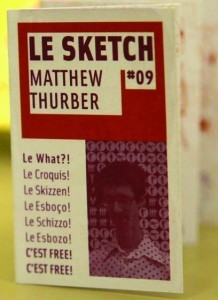
Le Sketch is a free mini-comic series with each issue devoted to a selection of sketches from a single contemporary cartoonist or illustrator. “Mini-comics are a wonderful example of just one of the formats artists are using to publish their comics. They are often self-published, have very limited print runs, are informally distributed— often for free—and therefore not regularly collected by libraries,” said Halsband.
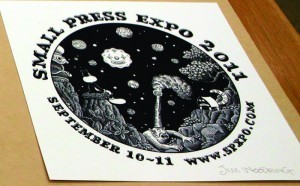 2011 SPX Festival tote bag
2011 SPX Festival tote bag
“SPX President Warren Bernard told us that original drawings by Jim Woodring such as this one on a tote bag, are rare because he has not given away or sold many,” said Duke.
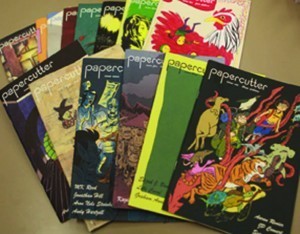 “Papercutter”
“Papercutter”
“Tugboat Press has donated a complete set of “papercutter” to the SPX Collection,” said Halsband. “This comic book anthology, which features young and emerging comic book artists, has been the recipient of numerous Ignatz awards since its debut in 2006.”
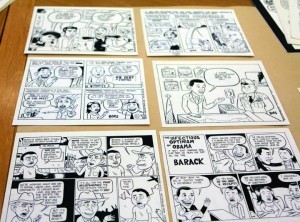 Matt Bors
Matt Bors
Matt Bors won the 2012 Herblock Prize for editorial cartooning. “Unlike the previous generation of cartoonists, Bors utilizes the Internet to reach his audience yet continues to work in traditional pen-and- ink media,” said Duke.
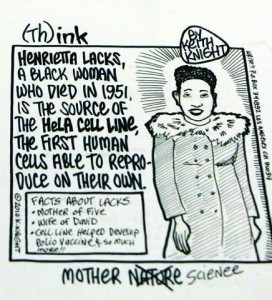 “(Th)ink”
“(Th)ink”
Keith Knight produces three cartoons each week: The Knight Life, The K Chronicles and (Th)ink. “This cartoon from (Th)ink reflects on the life of Henrietta Lacks, whose cells have been used for decades of scientific research,” said Duke.
About SPX
Founded in 1994, the Small Press Expo (SPX) is an annual festival in Bethesda, Md., for alterna- tive comic creators. SPX hosts the annual Ignatz Awards, which recognize outstanding achieve- ment in comics, cartooning and graphic novels.
Through an agreement reached with SPX in 2011, the Library can acquire independent com- ics and cartoon-art forms not received through copyright deposit.
MORE INFORMATION
Prints and Photographs Division Reading Room
Newspaper and Current Periodical Reading Room
These items are also spotlighted in the November-December 2012 issue of the Library of Congress Magazine, now available for download here. You can also view the archives of the Library’s former publication from 1993 to 2011.
December 10, 2012
Inquiring Minds: An Interview With Author William Martin
 What if Abraham Lincoln recorded his innermost thoughts as he moved toward the realization that he must end slavery? What if he lost that diary, but a recently discovered letter suggests that the diary is still out there? Such is the premise of “The Lincoln Letter” (Tor/Forge, 2012) by William Martin, his latest mystery novel featuring treasure-hunter Peter Fallon. Martin was at the Library today talking about his book, which he also researched here. I also had the opportunity to speak with Martin on his writing and his experience using the Library’s collections.
What if Abraham Lincoln recorded his innermost thoughts as he moved toward the realization that he must end slavery? What if he lost that diary, but a recently discovered letter suggests that the diary is still out there? Such is the premise of “The Lincoln Letter” (Tor/Forge, 2012) by William Martin, his latest mystery novel featuring treasure-hunter Peter Fallon. Martin was at the Library today talking about his book, which he also researched here. I also had the opportunity to speak with Martin on his writing and his experience using the Library’s collections.
Q. What inspired you to write “The Lincoln Letter?”
A. You don’t need a lot of inspiration to want to write about Lincoln. He’s such an interesting character, a man of great convictions and greater contradictions. I had written a bit about Lincoln in a novel called “Annapolis” (1996) and had decided then that some day I would come back to him in a larger way. My editor and I had talked a lot about the Emancipation Proclamation, too. So, I thought, a novel about Lincoln and the Proclamation, in its sesquicentennial year? It’s time.
Q. What about historical fiction appeals to you most?
A. The opportunity to live history before it becomes history, when no one knows how it will all turn out. You do that through fictional characters whose fates are intertwined with the historical events of their era and, sometimes, the historical figures of their time. That way, you also get to look the giants of history in the eye and see that they were as human as we are, and if they could endure and succeed, so can we.
Q. How do you stay true to the facts while incorporating the fiction?
A. In my books, historical characters never act contrary to what we know about them. And historical events never unfold in a way that leads to a different outcome. Other than that, well, never let the facts get in the way of a good story.
Q. Tell me about the research you did at the Library for “The Lincoln Letter.”
A. The digital revolution has been great for those of us who do not live in Washington. We are still able to access some of the remarkable Library of Congress materials on an instantaneous basis. Two places that I turned: to the online newspaper collection and to the image catalogue. I read the Washington Daily Republican on the Library’s site for most of the Civil War. I didn’t read it for the battle reporting. That was usually inaccurate or incomplete. I read it for the ephemera, the argot, the prose style and the advertisements. In essence, I read it to find out what people were thinking about and talking about when they weren’t talking about the war. I know, for example, that the Gosling Restaurant on Pennsylvania Ave. is a “happenin’” place. And Miss Laura Keene will be playing a week’s engagement at Ford’s Theater in “Our American Cousin,” which closes Friday. And that’s part of the excitement of reading the newspapers. You have a wonderful sense of dramatic irony as you read, because you know things that the people of the time didn’t.
Then there were the photographs. People have no idea of how many images of the Civil War you can find on the Library’s website, which is superbly arranged and very accessible. Creating Washington D.C. in 1862 became a much easier task when I had the images on the site to use. This is not, like most historical image collections, a pile of usual suspects. Some are extremely rare. There was one shot, for example, looking out from the Capitol at the [National] Mall, which was cut by a canal and covered at Seventh Street with the barracks of the Armory Square Hospital. I have never seen it before, anywhere, and it expressed how incomplete the Washington of 1862 was – like the nation.
Q. While researching this book, what did you learn about Lincoln and the Civil War that helped you develop your book?
A. I learned that Lincoln, the Great Emancipator, was also the Great Politician. And he had to be because the war he was fighting was not simply against the Southern slaveholders and their States Rights supporters. He was also fighting “the fire in the rear,” a collection of politicians, opinionators and other Northern opportunists who were advancing their own agendas – even at the nation’s expense – throughout the war. I had never considered any of that before I started researching.
Q. Some of your other books feature key American historical figures and documents. What is it about the nation’s history that inspires you in such a way?
A. I suppose that the clash of high ideals and base desires is a hallmark of all human history. But we see it vividly in American history. Take Civil War America. It was a nation that, as Lincoln often commented, proclaimed its commitment to the ideals of the Declaration of Independence and yet enslaved 10 percent of its population for profit. High ideals and base desires clash and create spectacular drama from 1861-65 and throughout our history.
Q. Have you used the Library’s collections for your other works?
A. Always, though not always directly. Everyone who does any kind of research touches upon the Library’s collections, even secondarily, through the work of other scholars. We are all beholden to the work of the Library of Congress.
Q. Are there any other periods in American history or historical figures you’d like to write about?
A. I have covered American history from the Pilgrims to 9/11, but there are still plenty of periods and events that I would like to drill more deeply into, like World War II or the building of the transcontinental railroad, And my imagination is inspired by place. We are products of the places we build, the places we destroy and those that we restore. Washington D.C. is a powerful character in “The Lincoln Letter.” I’d love to write about the rich history of California.
Q. Why do you think it’s valuable for the Library to preserve such historical items and what do you think the public should know about using them and doing research here?
A. Not only are we the products of the places we inhabit, we as Americans in the 21st century stand on the shoulders of all those who have thought, written, photographed, built and dreamed before us. Institutions like the Library of Congress are the great repositories of all those earlier aspirations. It is essential to a society’s sense of itself and its mission in history that those materials be preserved. They are national treasures, like the natural treasures we can visit in our national parks. Even if we never see Yellowstone, it’s important to us as a people to know that it’s there and that it’s part of our heritage. And that goes double for the materials that the Library has collected and catalogued. And all Americans should know that those collections, which help to define us as a people, are open to them in Washington and on line.
December 5, 2012
Dave Brubeck: A Legend in Life, and After
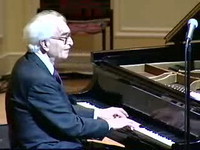
Dave Brubeck performs
Pianist Dave Brubeck, one of America’s all-time greats in the field of jazz — and a seminal force in making jazz popular in the U.S. and throughout the world — died today, just shy of his 92nd birthday.
The Librarian of Congress bestowed the Library’s “Living Legend” award on Brubeck in 2003, and it was our pleasure here at the Library to have Dave Brubeck on our stage in the Coolidge Auditorium both that year — he performed with the Dave Brubeck Quartet and the Brubeck Institute Sextet — and on April 10, 2008, where he was interviewed on the Coolidge stage by the journalist Hedrick Smith.
That evening, billed as as “The Dave Brubeck Quartet 1958 State Department Tour: The Music & The Memories,” featured a performance by the Brubeck Institute Jazz Quintet performing the works on the DBQ album, “Jazz Impressions of Eurasia.”
Dave Brubeck was interviewed in April 2008 for this webcast by the Library’s jazz specialist, Larry Appelbaum. Brubeck was known for his his million-selling recording “Time Out” and his use of different time signatures, as well as his songs “In Your Own Sweet Way,” “The Duke” and “Summer Song,” which are considered jazz classics, Appelbaum said.
“During the Cold War, he took jazz out to the world under the auspices of the State Department,” Appelbaum said. “He was one of the people who not only took American music abroad – he helped expose a lot of people to U.S. values through the music – but he also absorbed a lot of music he heard in Turkey, Eurasia and other places,” which became a part of Brubeck’s work.
December 4, 2012
A Global Toast to the Book
(The following is an article written by David A. Taylor, external relations and program development officer in Library Services, for the November-December 2012 issue of the Library of Congress Magazine. The article takes a look at an event this Thursday and Friday that will celebrate one of the most powerful and crucial forms of information transmittal: the book.
The book—arguably the greatest container of knowledge in history—will be celebrated at the Library of Congress, Dec. 6 and 7, on the occasion of the first-ever International Summit of the Book. Legislators, policymakers, educators, authors, publishers, technologists and librarians will come together to discuss the value of books in expressing our humanity and promoting cultural understanding. They will also explore the history of the book and how the book is changing and, in the process, revolutionizing knowledge and culture throughout the world.
The summit will celebrate the role of libraries as temples of knowledge and their role in preserving what societies have learned and transmitted. It will explore how technology can be harnessed to preserve the values of the book culture, provide access to knowledge that has been preserved in libraries and engage citizens and schools in taking full advantage of the knowledge resources available to them through their libraries.
This free, public event will feature a diverse group of distinguished speakers and a compelling display drawn from the Library’s collections.
The Library has selected a group of highly respected speakers who will analyze the book from a variety of essential perspectives. They will include authors, educators, legislators, historians, rare-book experts, legal scholars, librarians, digital-media specialists, publishers, copyright attorneys, members of Congress and other policymakers. Two keynote addresses, three lectures and three moderated panels comprise the symposium. Topics will range from the history of book publishing to the future of the book in a digital world.
A new Library exhibition, “Books that Shaped the World,” will be on view at the summit. The display builds on the Library’s recent exhibition, “Books That Shaped America.”
The summit will be the first in a periodic series of international summits, held in different cities around the world, which will examine the revolution in knowledge and culture through the book, whatever its forms. The 2012 event at the Library of Congress—and subsequent summits in other cities—will address reading and writing at a time when language, thinking and communication are dramatically changing. The 2013 Summit will be held in Singapore.
“It is an honor for Singapore to host the Second International Summit of the Book following the inaugural summit organized by the prestigious Library of Congress,” said Elaine Ng, CEO of the National Library Board of Singapore.
“We look forward to an insightful debate on the evolving concept of the book from an Asian perspective. We are privileged to have Professor Tommy Koh, Singapore’s Ambassador-At-Large and former Ambassador to the United Nations, as chairman of the organizing committee. We warmly welcome everyone to the summit.”
MORE INFORMATION:
International Summit of the Book
A download of November-December 2012 issue of the LCM will be available in its entirety here this week. You can also view the archives of the Library’s former publication from 1993 to 2011.
November 30, 2012
Gordon Parks Remembered
Gordon Parks once called his camera a “weapon against poverty and racism.” His poignant photographs documented all walks of life, from the poor and impoverished of Chicago, to the gangs of Harlem, to the fashions of Paris.
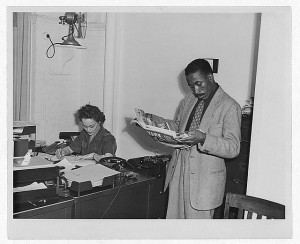
Gordon Parks, FSA/OWI photographer. 1943. Prints and Photographs Division.
Today would have been his 100th birthday. Parks was born on Nov. 30, 1912, in Fort Scott, Kansas. He died of cancer at the age of 94 on March 7, 2006. Over the course of his professional life, he produced substantive photography for the likes of the Farm Security Administration, Life Magazine and Vogue, wrote books and poetry, composed music and directed movies, two of which – “The Learning Tree” (1969), based on his autobiographical novel, and “Shaft” (1971) – will be preserved for all time as part of the National Film Registry of the Library of Congress.
Not bad for a teenager who was kicked out of his home at age 15 and forced to live by his wits. He worked in brothels, as a singer, a semi-professional basketball player and as a traveling waiter, among other things, all to survive – and to learn.
The photographs he produced for the FSA under the direction of Roy Stryker (1942-1943) and later for the Office of War Information, also under Stryker’s direction (1943-1945), were his first major projects. His images can be found in the Library’s FSA/OWI Black-and-White Negatives collection.
The Gordon Parks volume of the Library’s “Fields of Vision” book series featuring images from the FSA collection is one of the most popular.
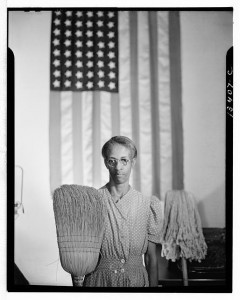
One of Parks’ most famous and enduring photos is of Ella Watson, government charwoman.1942. Prints and Photographs Division.
In 1995, the Library acquired his personal collection, including papers, music, photographs, films, recordings, drawings and other products of his long and creative career.
“I wanted all of my work to be under one roof, and I know of no roof I respect more,” he had said when making the donation.
Maricia Battle of the Prints and Photographs Division had the privilege of working with Parks on several occasions while helping to process his collection.
His body of work made him seem “larger than life,” she said. “But he was a real person. He made everyone feel like they belonged.”
Battle said it was vital to Parks to have his work freely available to everyone.
“He understood how important it was not to be housed in a box that no one would see,” she said. “And it’s important that young people and students have an idea that a man with simple beginnings achieved so much. It’s something anyone can do.”
November 29, 2012
Inquiring Minds: An Interview with Astrobiologist David H. Grinspoon
(The following is a guest post by Jason Steinhauer, a program specialist in the Library’s John W. Kluge Center, as part of the blog series, “Inquiring Minds.”)

Photograph by Henry Throop
American astrobiologist David H. Grinspoon began on November 1 as the inaugural Baruch S. Blumberg NASA/Library of Congress Chair in Astrobiology at the Library’s John W. Kluge Center. This unique position was established through an interagency agreement between the Library of Congress and the NASA Astrobiology Institute (NAI) for research into the origins, evolution, distribution and future of life in the universe, and the societal and humanistic implications of such inquiry. The chair is named for Baruch S. Blumberg, late Kluge Center Scholars Council member, Nobel Laureate and founding director of the NAI.
Grinspoon is curator of astrobiology at the Denver Museum of Nature & Science, adjunct professor at the University of Colorado, widely published writer, and currently serves on the Science Team for the Curiosity Rover mission to Mars.
Q: Tell us about what you’ll be researching at the Library of Congress.
A: My intention is to study the Anthropocene Era from an astrobiology perspective. The Anthropocene is the phrase that some scientists are using to refer to the geological era that is defined by human activity. It’s still controversial among geologists, as it acknowledges that we are having a global-scale impact on the Earth and looks at humans as a geological force. I intend to apply the perspective of astrobiology, which is a deep time way of looking at life on Earth, towards the question of the Anthropocene. What does the human phenomenon on Earth look like viewed from an interplanetary perspective?
Q: Can you explain astrobiology and deep time a bit?
A: Astrobiology is the science of life in the Universe. It’s an attempt to scientifically deal with the question of whether or not we’re alone in the universe, looking at the past of life, the present of life and the future of life. It’s an interdisciplinary study incorporating astronomy, biology and the Earth sciences. We’re studying our own history, but over a timescale of billions of years and including not just Earth but the other planets as well, which gives us more perspective on the possible stories and fates of worlds like our own.
Q: How does one become an astrobiologist?
A: Astrobiology is a new field. It draws on the heritage of exobiology. People come from a wide range of scientific backgrounds. My particular background is planetary science. I study how planets work. There’s been a growing sense of the need to include biology as an integral part of the way planets evolve. More recently I’ve been folding biology into my research about planetary history
Q: Were you always interested in outer space?
A: I was. I’m a child of Apollo. I was thrilled by the astronauts landing on the moon when I was in fourth grade. I was a science fiction geek from an early age, enthralled by the questions of life in the universe. As I got older I learned that space exploration was real. I wanted to get involved in that. I knew I wanted to be a scientist. Now I’m on the science teams of spacecraft that are currently operating at Mars and Venus. Living the dream!
Q: What are you most excited to look at in the Library of Congress collections?
A: I’m very excited to explore the papers of notable scientists. I’m going to integrate the history of science into my research, and so it’s exciting to be able to find primary material. Beyond that, astrobiology is such a multi-disciplinary field with elements of philosophy, history, theology and spirituality that can be folded into this study. I feel so incredibly fortunate to have the resources of the Library at hand.
Q: Part of your role will be to organize public events. What are the ways that the public can get involved in astrobiology?
A: Astrobiology is a great point of contact for science outreach. The public is naturally interested in extra-terrestrial life. Astrobiology provides an accessible point of access that leads to deeper questions. In the museum where I work in Denver, astrobiology has been a great way to bring the public interest into scientific questions. Here at the Library, through workshops and colloquia I hope to explore the boundaries of science and the humanities. How do we illuminate the meaning of human existence through our science and its philosophical and spiritual dimensions? Collaboration with others at the Library and in Washington makes this an ideal place to do that.
November 21, 2012
Let’s Give Thanks
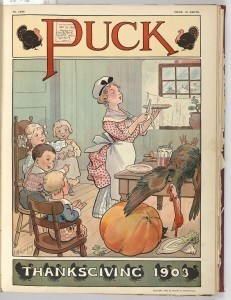 Thanksgiving is just a day away, and I’ve been noticing on Facebook, friends posting what they are thankful for this holiday season. Those statuses certainly have given me pause to count my own blessings.
Thanksgiving is just a day away, and I’ve been noticing on Facebook, friends posting what they are thankful for this holiday season. Those statuses certainly have given me pause to count my own blessings.
First and foremost, I am thankful for my family, who, no matter how far away I am from them, help me stay grounded in where I came from. You can take the girl out of Mississippi, but you can’t take Mississippi out of the girl!
I’m thankful for roller derby. Yes, that may be a strange thing to say, but it’s through participation in this sport that I have not only found lifelong friends but also strength and courage to stick with something very challenging and really live up to the “never give up” mantra. There’s definitely a life lesson in that.
Last but certainly not least, I’m thankful for having the opportunity to really learn something new every day. Part of the mission of the Library of Congress is to further human understanding by providing access to knowledge through its amazing collections. I can honestly say that I really do take advantage of that. And, so can you. Currently, the Library makes freely available on its website more than 31 million items, from manuscripts and newspapers to films, sound recordings and photographs.
To bring it home in celebration of turkey, stuffing, pecan pie, a table full of friends and family and anything else you can think of that makes Thanksgiving special to you, here are some interesting facts I’ve learned about the holiday thanks to working here at the Library.
One could argue the first “thanksgiving” was actually celebrated In May 1541, when Spanish explorer Francisco Vasquez de Coronado and 1,500 men celebrated at the Palo Dur Canyon — located in the modern-day Texas Panhandle — after their expedition from Mexico City in search of gold. In 1959 the Texas Society Daughters of the American Colonists commemorated the event as the “first Thanksgiving.”
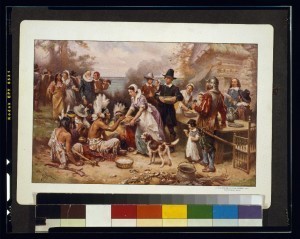
The first Thanksgiving, 1621 / J.L.G. Ferris. Prints and Photographs Division.
Another “first Thanksgiving” occurred on June 30, 1564, when French Huguenot colonists celebrated in a settlement near Jacksonville, Fla. This “first Thanksgiving,” was later commemorated at the Fort Carolina Memorial on the St. Johns River in eastern Jacksonville.
The harsh winter of 1609-1610 generated a famine that caused the deaths of 430 of the 490 settlers in Jamestown, Va. In the spring of 1610, the surviving colonists enjoyed a Thanksgiving service after English supply ships arrived with food. This colonial celebration has also beenconsidered the “first Thanksgiving.”
Following the Revolutionary War, the Continental Congress recognized the need to give thanks for delivering the country from war and into independence. Congress issued a proclamation on October 11, 1782, which proclaimed the observation of Thursday the twenty-eight day of November next, as a day of solemn Thanksgiving to God for all his mercies.”
Today, Thanksgiving is celebrated on the fourth Thursday in November. But that was not always the case.
When Abraham Lincoln was president in 1863, he proclaimed the last Thursday of November to be our national Thanksgiving Day. Newport native Sarah Josepha Hale had written a to President Lincoln in the midst of the Civil War, entreating him to make Thanksgiving an official national holiday.
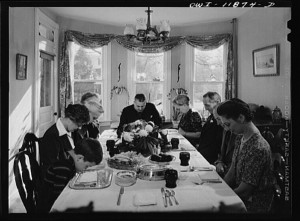
Saying grace before carving the turkey. Nov. 1942. Prints and Photographs Division.
In 1865, Thanksgiving was celebrated the first Thursday of November, because of a proclamation by President Andrew Johnson, and, in 1869, President Ulysses S. Grant chose the third Thursday for Thanksgiving Day. In all other years, until 1939, Thanksgiving was celebrated as Lincoln had designated, the last Thursday in November. Then, in 1939, responding to pressure from the National Retail Dry Goods Association to extend the Christmas shopping season, President Franklin D. Roosevelt moved the holiday back a week, to the next-to-last Thursday of the month.
Follow the history of Thanksgiving celebrations in the Thanksgiving Timeline.
For our forbears, frontier life in the 19th century offered challenges to pioneers but also provided opportunities to give thanks. To hear remembrances of Thanksgivings past, search on “Thanksgiving” in American Life Histories, 1936-1940.
So, what are you thankful for this holiday season?
November 16, 2012
Library in the News: October Edition
With the November opening of the new exhibition “The Civil War in America” only a month away, media outlets picked up on the announcement of a new blog featuring historical voices from the war.
The Associated Press wrote an announcement that many outlets ran with, including The Washington Post, WTOP, military.com and various broadcast affiliates of CBS, ABC, NBC and Fox. Also spotlighting the blog with individual coverage was the Daily Kos blog and the Washington Times, which took an in-depth look at one of the voices, Elizabeth Keckley.
“She is finally being remembered at the Library of Congress Civil War exposition next month and restored to her historical place in the Lincoln saga,” wrote Martha M. Boltz.
Continuing to make the headlines in October was news about Poet Laureate Natasha Trethewey and the 12th annual National Book Festival.
Trethewey gave her inaugural reading to kick off the Library’s literary season on Sept. 13 and was featured speaker at the National Book Festival, who actually spoke for the first time at the festival in 2004.
Rosalind Bentley of the Atlanta Journal-Constitution spoke with Trethewey, detailing her personal journey as a poet.
“[James] Billington believes the time for this kind of poet is right now,” she wrote of Trethewey’s laureateship. “She is only 46 and in the prime of her artistic life. This will signal that the Library is looking forward.”
In an interview with Roll Call, Trethewey told reporter Rebecca Baird-Remba, “I’m always interested in investigating my relationship with the past. I write to make sense of this history we’ve been given, and I write so that we can be a nation that is reckoning with the past, instead of one that has amnesia about it.”
Among countless articles far and wide on the book festival — from The Clarion Ledger to Asian Fortune News — was this gem from philly.com by author Lisa Scottoline, who writes a regular column for the Philadelphia Inquirer titled “Chick Wit.”
“There can be no greater pleasure, as a parent, than watching your child come fully into her own, taking all of her God-given talents and putting them to their most perfect use,” she said of watching her daughter, author Francesca Serritella, giving her presentation. “That feeling? It’s Mom Heaven.”
Library of Congress's Blog
- Library of Congress's profile
- 74 followers



